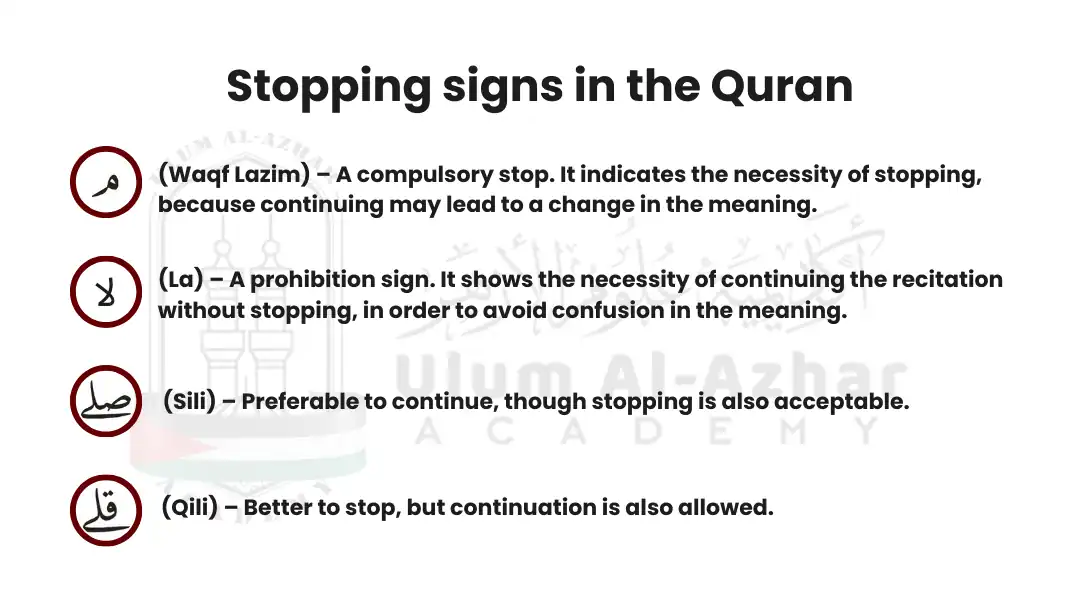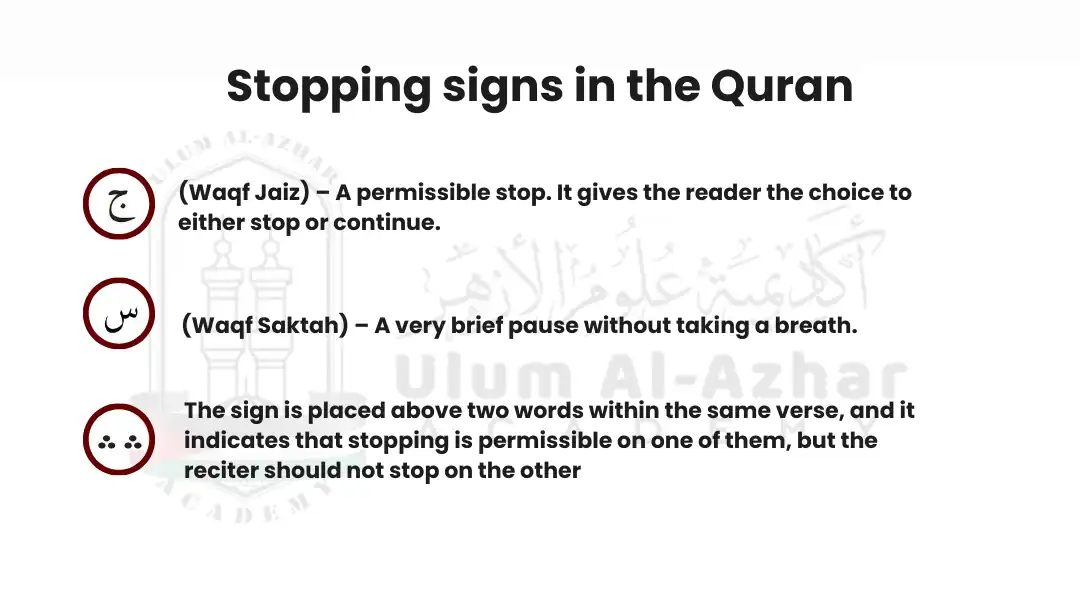
Stopping Signs in the Quran: Meanings and Tajweed Rules
Have you ever listened to a masterful recitation of the Quran and felt the deep reverence conveyed through every pause and breath? The Quran is not an ordinary book; it is the sacred, divine word of Allah revealed to Prophet Muhammad ﷺ. This profound beauty is captured and preserved through Tajweed, the art and science of proper recitation. At the heart of this system are the Stopping Signs in the Quran, which are not just symbols, but vital guides ensuring correct pronunciation, rhythm, and profound respect for the meanings of Allah’s words.
Learning these signs are crucial for a recitation that is both correct and spiritually uplifting. In this article, we will delve into the significance of these stopping signs, their meanings, how they enhance Tajweed, and how aspiring reciters can master them with the guidance of qualified teachers.
Table of Contents
Importance of stopping signs in the Quran
Stopping signs in the Quran are small symbols that appear in the Noble Qur’an to indicate to the reader where it is preferable to stop or continue during recitation. The placement and manner of stopping are received from the Messenger of Allah ﷺ.
ʿAli ibn Abi Talib (may Allah be pleased with him) was asked about the saying of Allah, the Exalted: ‘and recite the Qur’an with measured recitation’ {Al-Muzzammil: 4}. He replied: It means the proper articulation of the letters and the knowledge of stopping points.
So, the importance of stopping signs in the Quran appears in:
They preserve the meaning – A misplaced pause can change the meaning of a verse entirely.
They aid proper Tajweed – Tajweed is not only about articulation but also about when to stop and continue.
They follow the Sunnah – The Prophet ﷺ recited with measured pauses, and the companions memorized his style.
They help non-Arabic speakers – For learners worldwide, stopping signs serve as a universal guide.
Initiate your bespoke Islamic learning experience with a free consultation, guided by Al-Azhar-certified Sheikhs from Egypt.
Common stopping signs and their meanings
Scholars have classified Stopping Signs in the Quran into several main categories. Among the types of stopping is what is considered improper. This includes stopping at a point where the speech is incomplete and still connected to what follows, such as stopping at the subject without its predicate, the verb without its subject, or a particle of accusative without its object.
Even worse is stopping at a point that could imply an attribute unbefitting of Allah, the Exalted—for example, stopping at the word ‘yastahyi’ (He is shy) in the verse: ‘Indeed, Allah is not shy to present an example’ {Al-Baqarah: 26}. Such a stop is not permissible except out of necessity. In that case, the reciter should repeat the word at which he stopped—if doing so does not alter the meaning—or otherwise restart from a point that is proper to begin with.
Each symbol indicates whether the reader should stop, continue, or has the option. Some of the most common ones include:
How stopping signs improve Tajweed
Stopping is the act of cutting off the sound at the end of a word for a duration in which one normally takes a breath, with the intention of resuming recitation and not abandoning it. It should be accompanied by the basmalah at the beginning of surahs, and it may occur at the end of verses or in their middle, but not in the middle of a word nor where the writing is connected.
So, Stopping Signs in the Quran are directly connected to Tajweed because Tajweed is not only about letters but also about rhythm. Stopping and starting signs help you apply the rules of Tajweed, as they assist in controlling breath and rhythm, which in turn ensures the correct pronunciation of words.
Practical examples from famous surahs
Let us look at some examples where Stopping Signs in the Quran appear and why they matter:
م (Waqf Lazim) – إِنَّمَا يَسْتَجِيبُ ٱلَّذِينَ يَسْمَعُونَ ۘ وَٱلْمَوْتَىٰ يَبْعَثُهُمُ ٱللَّهُ ثُمَّ إِلَيْهِ يُرْجَعُونَ
Only the attentive will respond ˹to your call˺. As for the dead, Allah will raise them up, then to Him they will ˹all˺ be returned (Al-An’am 36)
لا (La) – ٱلَّذِينَ تَتَوَفَّىٰهُمُ ٱلْمَلَـٰٓئِكَةُ طَيِّبِينَ ۙ يَقُولُونَ سَلَـٰمٌ عَلَيْكُمُ ٱدْخُلُوا۟ ٱلْجَنَّةَ بِمَا كُنتُمْ تَعْمَلُونَ
those whose souls the angels take while they are virtuous, saying ˹to them˺, “Peace be upon you! Enter Paradise for what you used to do (An-nahl 32)
صلي (Sili) – وَإِن يَمْسَسْكَ ٱللَّهُ بِضُرٍّۢ فَلَا كَاشِفَ لَهُۥٓ إِلَّا هُوَ ۖ وَإِن يَمْسَسْكَ بِخَيْرٍۢ فَهُوَ عَلَىٰ كُلِّ شَىْءٍۢ قَدِيرٌ
If Allah touches you with harm, none can undo it except Him. And if He touches you with a blessing, He is Most Capable of everything (Al-An’am 17)
قلي (Qili) – قُل رَّبِّىٓ أَعْلَمُ بِعِدَّتِهِم مَّا يَعْلَمُهُمْ إِلَّا قَلِيلٌۭ ۗ فَلَا تُمَارِ فِيهِمْ إِلَّا مِرَآءًۭ ظَـٰهِرًۭا وَلَا تَسْتَفْتِ فِيهِم مِّنْهُمْ أَحَدًا
Say, ˹O Prophet,˺ “My Lord knows best their ˹exact˺ number. Only a few people know as well.” So do not argue about them except with sure knowledge, nor consult any of those ˹who debate˺ about them (Al-Kahf 22)
ج (Waqf Jaiz) – نَّحْنُ نَقُصُّ عَلَيْكَ نَبَأَهُم بِٱلْحَقِّ ۚ إِنَّهُمْ فِتْيَةٌ ءَامَنُوا۟ بِرَبِّهِمْ
We relate to you ˹O Prophet˺ their story in truth. They were youths who truly believed in their Lord, and We increased them in guidance (Alkahf-13)
س (Waqf Saktah) – ٱلْحَمْدُ لِلَّهِ ٱلَّذِىٓ أَنزَلَ عَلَىٰ عَبْدِهِ ٱلْكِتَـٰبَ وَلَمْ يَجْعَل لَّهُۥ عِوَجَاۜ
All praise is for Allah Who has revealed the Book to His servant, allowing no crookedness in it (Al-Kahf 1).
The last one of Stopping Signs in the Quran

These examples show that without respecting Stopping Signs in the Quran, a reader may lose the spiritual depth and clarity of Allah’s words.
Learning stopping signs with certified tutors
Al-Qasim ibn ʿAwf al-Bakri said: I heard ʿAbdullah ibn ʿUmar say: “We lived for a period of time in our lives when one of us was given faith before the Quran. Then a surah would be revealed to Muhammad ﷺ, and we would learn its lawful and unlawful matters, and what should be stopped at within it, just as you learn the Qur’an today.
But we have seen today men who are given the Quran before faith, so he recites it from its beginning to its end without knowing what commands him or forbids him, nor what should be stopped at within it.” Al-Nahhas said: “This hadith indicates that they used to learn the stopping points just as they learned the Qur’an.
So learning stopping signs in the Quran must be taken from certified teachers (mashayikh). Save time & effort by Ulum Al-Azhar Tajweed Classes where you study Tajweed and Quran, by qualified Egyptian Al-Azhar Sheikhs.
Conclusion
The Qur’an is not merely a text to be read—it is a divine revelation to be recited with precision and devotion. Stopping Signs in the Quran are an essential part of this process. They ensure that the meaning is preserved, Tajweed is perfected, and the reciter follows the Sunnah of the Prophet ﷺ.
By learning the meanings of these signs, practicing them in famous surahs, and studying under certified tutors, every Muslim can enhance their Qur’an recitation. Truly, the beauty of the Qur’an shines brightest when it is recited with care, rhythm, and understanding.
Engage in a free consultation with Al-Azhar-certified Sheikhs from Egypt to tailor your Islamic learning experience.
FAQs
What are Stopping Signs in the Quran?
Stopping Signs in the Quran are symbols that guide reciters on where to pause, continue, or briefly stop in order to preserve meaning and Tajweed rules.
Are Stopping Signs in the Quran part of Tajweed?
Yes. Tajweed includes articulation, elongation, and correct pausing. Without Stopping Signs in the Quran, Tajweed would be incomplete.
Why are some stops mandatory and others optional?
Because Qur’anic scholars analyzed the meanings and grammar. Some verses lose meaning if you continue, while others remain valid whether you pause or not.




